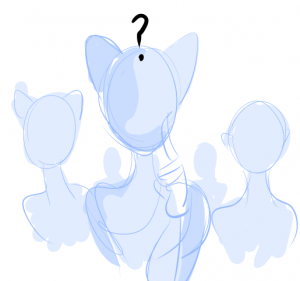Hinichi: Difference between revisions
No edit summary |
|||
| Line 11: | Line 11: | ||
* '''Average Height:''' | * '''Average Height:''' | ||
* '''Average Lifespan:''' | * '''Average Lifespan:''' | ||
* '''Gravity Preference:''' | * '''Gravity Preference:''' medium | ||
* '''Homeworld:''' Hinichitii | * '''Homeworld:''' Hinichitii | ||
* '''Native Language:''' | * '''Native Language:''' | ||
==Appearance== | ==Appearance== | ||
Revision as of 00:32, 14 January 2022
The Hinichi are a wolfine Pelted race.
Vital Statistics (At a Glance)
Pronounced 'hee-nee-chee[1] '. Singular is . Possessive is . Plural is .
- Species Type: Pelted
- Origin: Engineered
- Frame Type: Bipedal, both plantigrade and digitigrade possible
- Average Height:
- Average Lifespan:
- Gravity Preference: medium
- Homeworld: Hinichitii
- Native Language:
Appearance
Hinichi can have all the pelt patterns of their lupine ancestors (and name those patterns according to seasons, with reddish and blond Hinichi being ‘spring’ and ‘summer’ colored, while gray and black and pale Hinichi being fall and winter-colored). Hinichi can have a flat face, a demimuzzle or muzzle [...]; you can be plantigrade or digitigrade, have four fingers and claws or five and nails.[2] 'Wolves-of-all-seasons - winter white, spring's ocher and yellow-brown, summer's deep browns and finally the grey and black of autumn. White ears tipped with black are called 'Mother Mary' ears, acclaimed among the Hinichi for their loveliness. They are prized and rare, considered to have more of the Hinichisene in them than the rest. Winter Hinichi are white and ivory, Autumn is black and gray. Summer is deep browns and reds while spring is yellowish-browns and oranges. [3]
Society
Member of what nations here. Information about colony worlds here.
Stereotypes
The Hinichi, on the other hand, are people of the Book: literally, having adopted and adapted Christianity into a form that bemuses those who still practice on Earth. They are reputed throughout the Alliance for their faith, their emphasis on family, and their commitment to duty. Being Pelted, they are missing an inbred respect for authority or tradition—Pelted have few of those—but their wolf-like natures lead them to far more complex and stable social networks than their Harat-Shariin brethren, whose solitary-predator leanings influence their far more laissez-faire approach to relationships. The Hinichi homeworld tends toward the cold and craggy, and their mountain society is distinctly feudal in tenor, while the lowlands tend toward the more egalitarian. They are excellent people to have at your back in a pinch: once they give their loyalty, it’s hard to shake them loose again.[2]
If you believe strongly in duty, or have a strong core of faith and belief, and if you are comfortable in a complex and often broad social hierarchy/network, you may want to be Hinichi: from the mountain cultures if you feel a strong connection to the feudal sense of obligation between vassal and liege, or from the lowlands if you are more interested in the broader society of the Alliance. If wrestling with faith is a strong theme in your life, you may want to be one of the rare Pagan or agnostic/atheist Hinichi—they do exist, but they struggle to define themselves against the backdrop of the unshakable faith of their fellows, who use religion to come to terms with having been created by humanity.[2]
Common Family Structures
Religions
Many of them have adopted the Christian religion.
The Hinichi have the tradition of Godbraids, known by lowlanders as 'prayer-plaits'. They are braided when you want to remind yourself and God of one of your prayers to Him. If it's a petition, it is braided with faceted crystals, while gratitude is beaded with cabochons. Remembering someone in prayers is beaded with metal beads and little decorations that remind you of that person. Each braid is for a separate prayer.
There are different sects of Hinichi religious thought. One is the pruscha - they are a much stricter sect and believe that pride is the worst of the seven deadly sins. They preach that babies born appearing too 'human' are demons sent to tempt the Hinichi into breeding themselves to appear as the Messiah did. The sathet sect is much less strict and does not have the same belief on Hinichi that appear more human than wolfine.
They also stuff things with their shed fur to give as gifts: pillows, dolls, etc.
Native or Common Dress
Naming Conventions
The Hinichi’s names are usually Scottish or Irish-derived with added Biblical first names. They observe surname conventions as well, based on blood family ties. The Guardkin, who consider themselves and the Hinichi brethren races, typically follow their conventions with additional Welsh influences… though they trace blood ties using ‘son/daughter of [name and name]’ and use a second surname to denote the family of the Hinichi handlers primarily responsible for their care, if they have one.[4]
Language
"If the Hinichi ever had a full language, all the evidence of it we have left is a relatively sparse vocabulary." [3]
- decherna: "my sister" (plural dechernasen)
- chuniisu: "my brother"
- -scain: "leaders, nobles"
Guardkin
The Hinichi developed a race? breed? of intelligent dogs or wolves or wolf-dogs (or as Liolesa would have it, mouthy throw-rugs) who, unbeknownst to the Hinichi themselves, could communicate psychically with people who have esper talents. See the Guardkin page for more information.
Hinichi Characters
References
- ↑ "Pronunciation Guide," Even the Wingless backmatter
- ↑ 2.0 2.1 2.2 The Pelted Guidebook
- ↑ 3.0 3.1 Claws and Starships , "Butterfly"
- ↑ "Naming Conventions" article on Patreon
